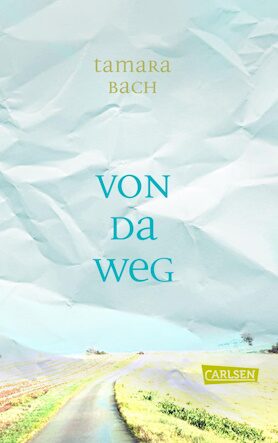Tamara Bach
Von da weg
[Leaving There]
- Carlsen Verlag
- Hamburg 2024
- ISBN 978-3-551-58543-1
- 176 Pages
- Publisher’s contact details
Sample translations
You Can’t Get More Alone
Interestingly, the popularity of Tamara Bach’s highly acclaimed novels rarely lies in the story itself. Indeed one might even call them unspectacular as they don’t deal with major catastrophes. Instead, they focus on everyday issues that occupy and challenge young people around the world: the difficulties associated with changing schools and first love, unexpected encounters and parents divorcing, friendship and loneliness. Frequently, she turns her attention to questions around identity and where one is heading in life.
The language, form and structure of Tamara Bach’s books are unique and very special, and “Von da weg” is no exception in this regard. Kaija, the protagonist of the novel, has moved with her parents from a large city in the north to a small town in the south of Germany and is struggling with her new surroundings. At school she is treated as an outsider, and her previous class has removed her from their group chat. The home they move back into is occupied by the mother’s old aunt, who seems slightly demented. Kaija’s mother teaches at her new school and seems out of place in her old hometown. “You can’t get more alone,” she thinks at one point. Only the father, an American and artist, takes everything with a grain of salt and cheerfully keeps the family in a good spirit. He serves up good food and good solutions to all sorts of problems.
All sorts of questions come to the reader’s mind: Why did the family move there in the first place? Was it to take care of the old aunt? Or perhaps because of Kaija’s problems? Why does the mother try to avoid old acquaintances? Or: What could the monosyllabic Aunt Josepha tell us about her life? These are questions that are not addressed directly, but rather surface delicately beneath or behind the story. Questions that are not fully answered and therefore hover over the plot until the very end.
Several such gaps and ambiguities are part and parcel of many of Tamara Bach’s books, and readers need not be irritated by them, rather they make her stories seem interesting and authentic. The author’s idiosyncratic narrative style is also typical of her writing. Her sentences are short, concise, and condensed. They describe people’s behavior and events, but never does she interpret or comment on them. Many things are only hinted at and not explained in detail, but there is a clarity and power in all the sentences that is supported by subtle rhythms, repetitions, rearrangements and missing words. Simple on the surface but complex in its structure, “Von da weg” is like a slightly blurred photograph that cannot be brought into focus and thus retains its mystery.
Surely many young people can imagine themselves wanting to “get away from here” without having a concrete destination in mind. The non-conformist great-aunt also had wanted to do this, as did the travel-loving mother, facts that we discover in separate narrative threads throughout the story. This makes the constellation of characters even more differentiated and allows us to understand some of the very different emotional or factual obstacles that all three generations have to overcome in order to finally not want to leave.
Tamara Bach has once again written a young adult novel that will find many readers because it addresses fundamental themes such as: wanting to leave and returning, home and longing for faraway places, foreignness and sense of security. Translators may find the work challenging, given the subtle allusions and emphases, the linguistic subtleties and idiosyncrasies. The tones and nuances need to be conveyed in such a way that they can unfurl their subtle effect. Undoubtedly, this slim novel will be received just as enthusiastically abroad as in Germany.
Translated by Zaia Alexander

By Sylvia Schwab
Sylvia Schwab is a radio journalist with a special interest in literature for children and teenagers. She serves on the jury for the monthly ‘Best 7’ list of books for young readers produced under the aegis of Deutschlandfunk and Focus, and works for Hessischer Rundfunk, Deutschlandfunk and Deutschlandradio-Kultur.
Publisher's Summary
You can find friends even at the end of the world!
Kaija moves with her family to the place where her mother Ruth and great-aunt Josepha grew up. Now Kaija is new, and her friends are far away. And in the very first week after the move, they don't get in touch. So Kaija has to find her own way, make her own decisions and find out who she really is and what friendship really means. And Ruth and Josepha also have to arrive at the end of the world, where they were desperate to get away from. But luckily there is Emily, lots of cats and the prospect of a new beginning.
Tamara Bach tells the story authentically, poignantly and with a great deal of humour, giving Kaija, Ruth, Josepha and all the others unforgettable voices.
An impressive, warm-hearted book about families and real friends!
(Text: Carlsen Verlag)
